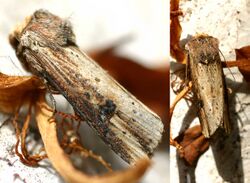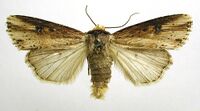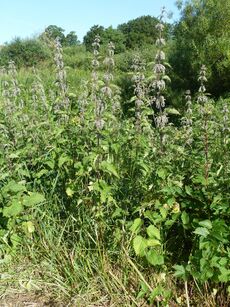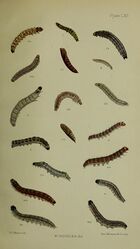Biology:Axylia putris
| The flame | |
|---|---|

| |
| Scientific classification | |
| Domain: | Eukaryota |
| Kingdom: | Animalia |
| Phylum: | Arthropoda |
| Class: | Insecta |
| Order: | Lepidoptera |
| Superfamily: | Noctuoidea |
| Family: | Noctuidae |
| Genus: | Axylia |
| Species: | A. putris
|
| Binomial name | |
| Axylia putris (Linnaeus, 1761)
| |
The flame (Axylia putris) is a moth of the family Noctuidae. It is found throughout Europe then east across the Palearctic to Armenia, western Siberia and Amur, Korea and Japan . The range extends into northern India.
This species has creamy-buff forewings (sometimes tinged with red) with black streaking along the costa. The hindwings are whitish with a dark line along the margin. The wingspan is 30–36 mm. Unusually for a noctuid, this moth rests with its wings wrapped tightly around its body making it resemble a broken twig. It flies at night in June and July (sometimes a second brood is produced which flies in September)[1] and is attracted to light.
Description
Forewing ochreous, the costal area, including cell, dark brown; dark brown patches at the outer margin on both folds, the upper connected with outer line by a dark double streak; inner line strongly angulated; outer represented by a double row of vein-dashes: orbicular and reniform stigmata with dark centres and rings; the former small and round, more rarely flattened: the latter large; hindwing whitish, variably suffused with grey; — the form triseriata Moore, originally described from N. India, but occurring in Japan and Korea as well, is larger and darker.[1]
Biology
The larva is grey or brown with black markings and a hump at the rear end. It feeds on a variety of cereals and other herbaceous plants (see list below). The species overwinters as a pupa.
- ^ The flight season refers to the British Isles. This may vary in other parts of the range.
Recorded food plants
- Beta – beet
- Galium – bedstraw
- Hordeum – barley
- Lotus – bird's-foot trefoil
- Medicago – alfalfa
- Polygonum
- Rumex – dock
- Secale – rye
- Taraxacum – dandelion
- Trifolium – clover
- Triticum – wheat
- Urtica – nettle
- Vicia – vetch
Notes
- ↑ Seitz, A. Ed., 1914 Die Großschmetterlinge der Erde, Verlag Alfred Kernen, Stuttgart Band 3: Abt. 1, Die Großschmetterlinge des palaearktischen Faunengebietes, Die palaearktischen eulenartigen Nachtfalter, 1914
- ↑ "Robinson, G. S., P. R. Ackery, I. J. Kitching, G. W. Beccaloni & L. M. Hernández, 2010. HOSTS - A Database of the World's Lepidopteran Hostplants. Natural History Museum, London.". http://www.nhm.ac.uk/research-curation/research/projects/hostplants/.
References
- Chinery, Michael Collins Guide to the Insects of Britain and Western Europe 1986 (Reprinted 1991)
- Skinner, Bernard Colour Identification Guide to Moths of the British Isles 1984
External links
- The Flame at UKmoths
- The Flame at Markku Savela's Lepidoptera pages (Funet)
- Lepiforum.de
- Vlindernet.nl (in Dutch)
Wikidata ☰ Q301172 entry
 |




